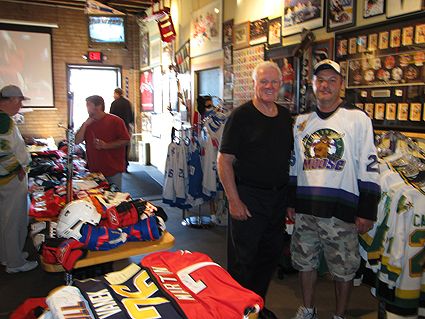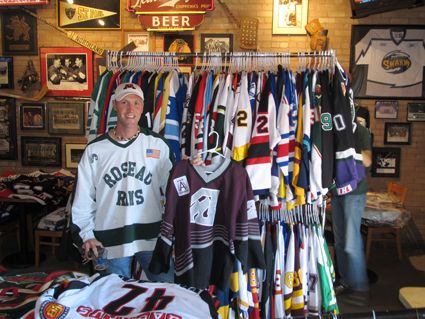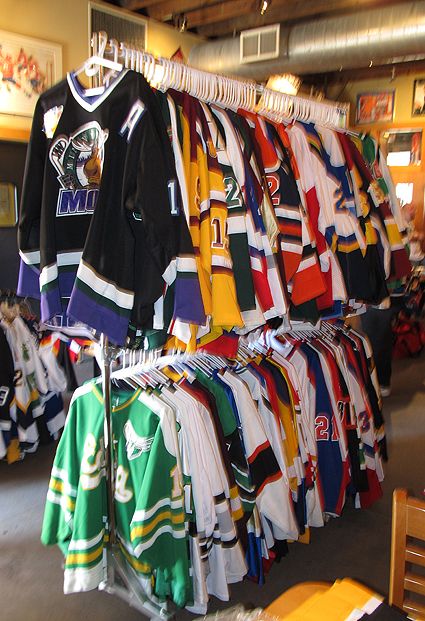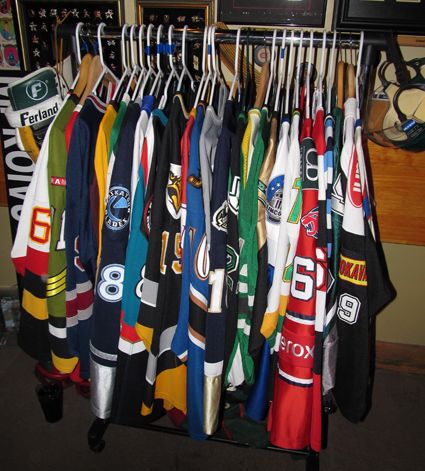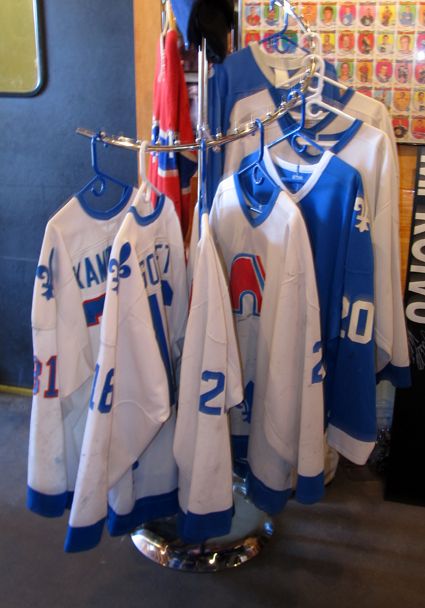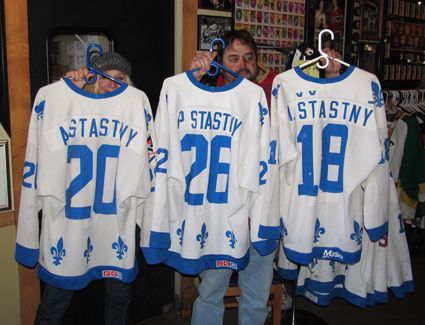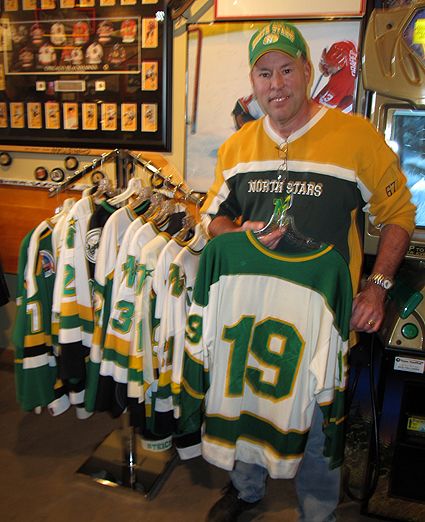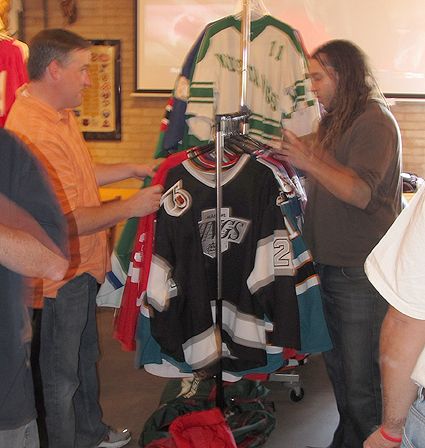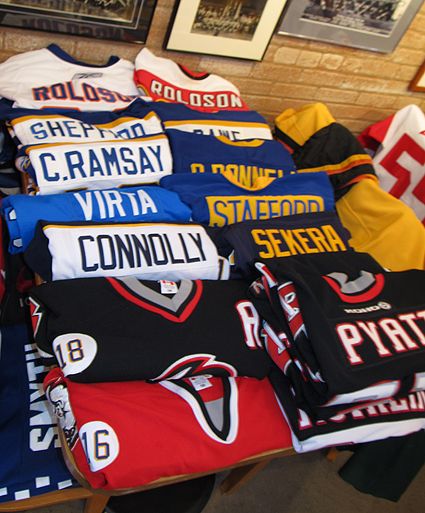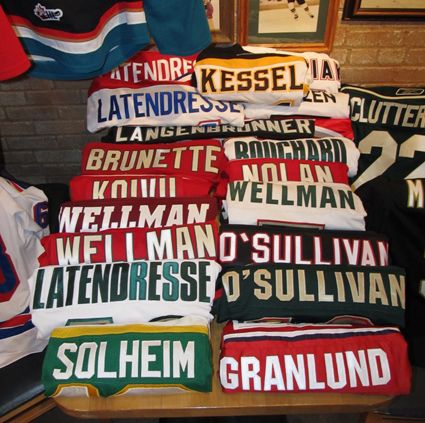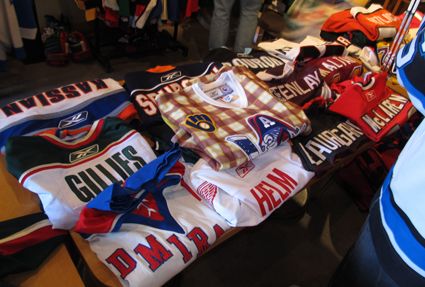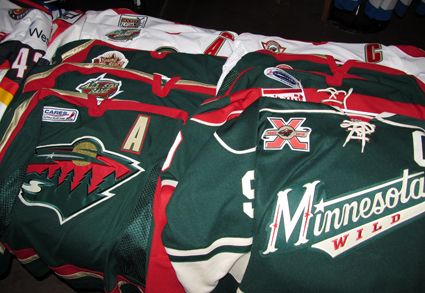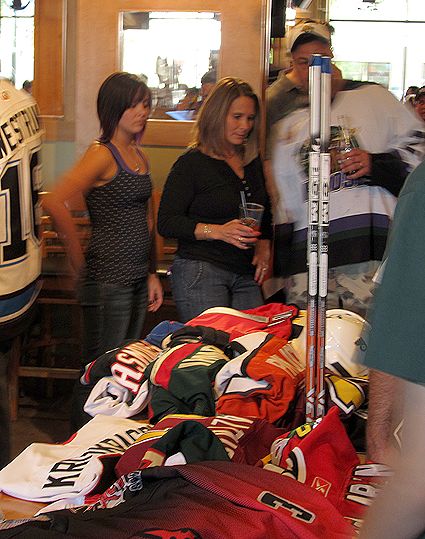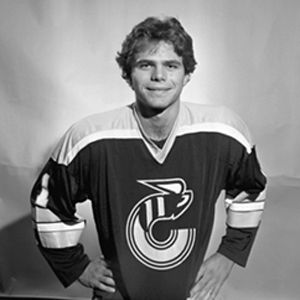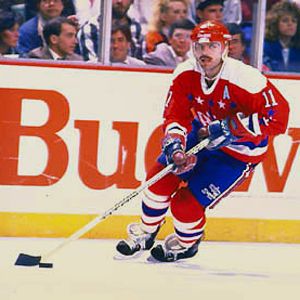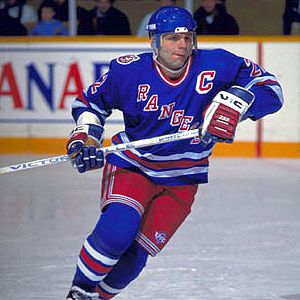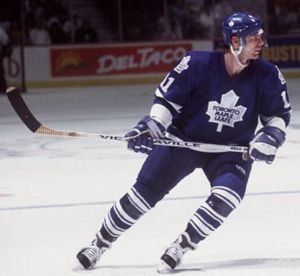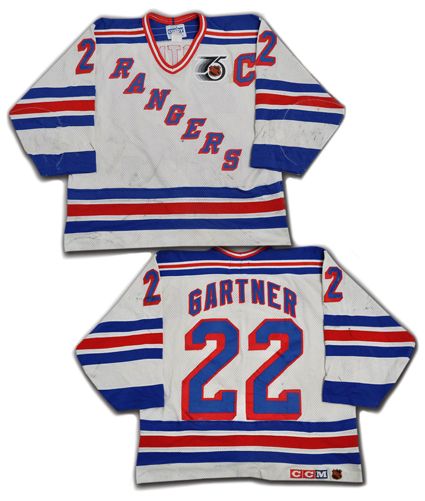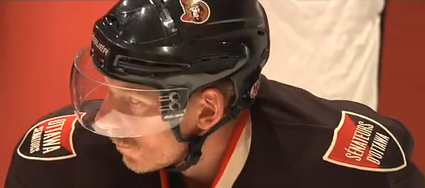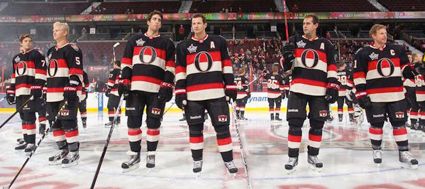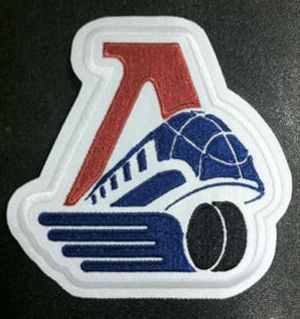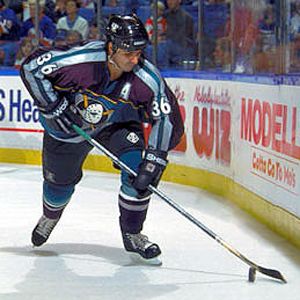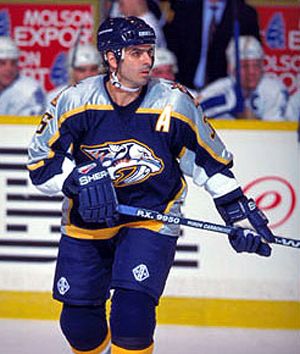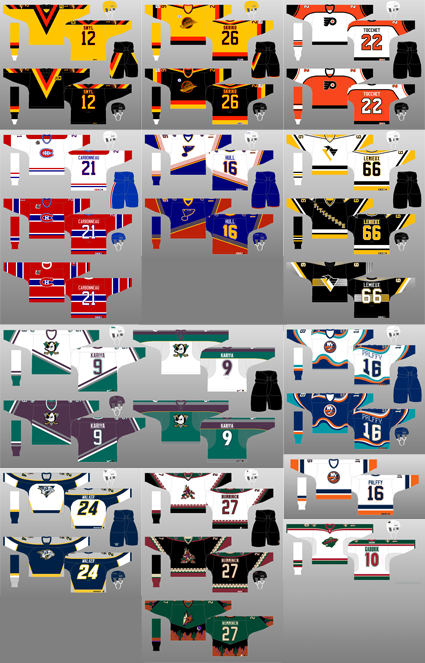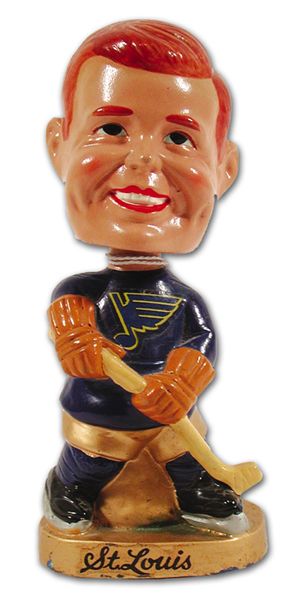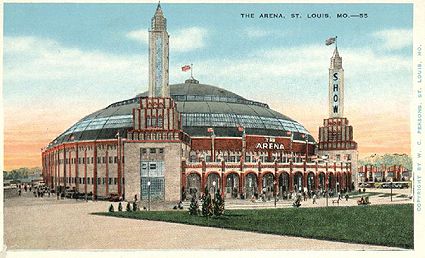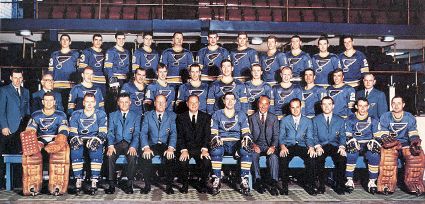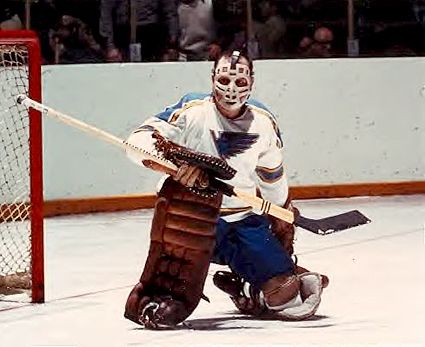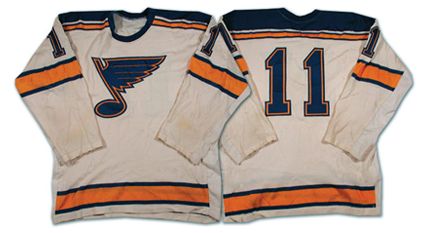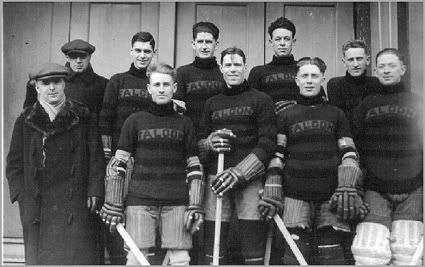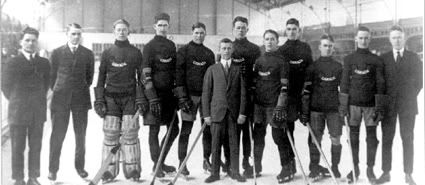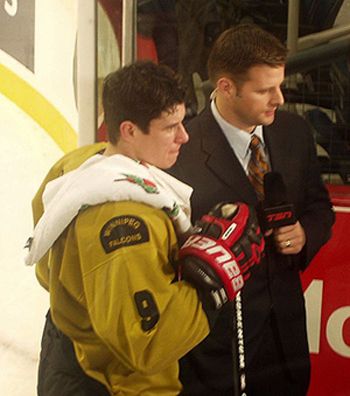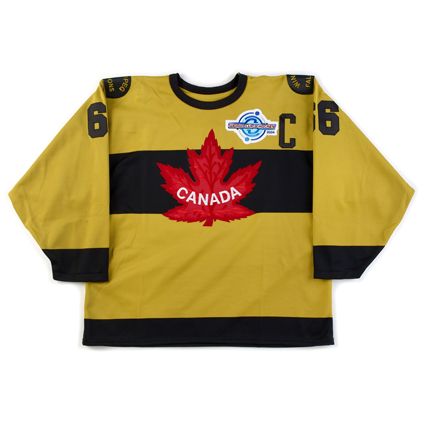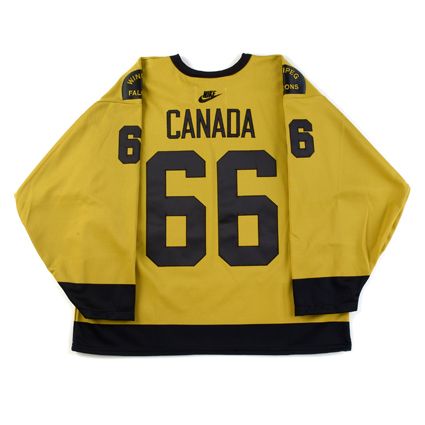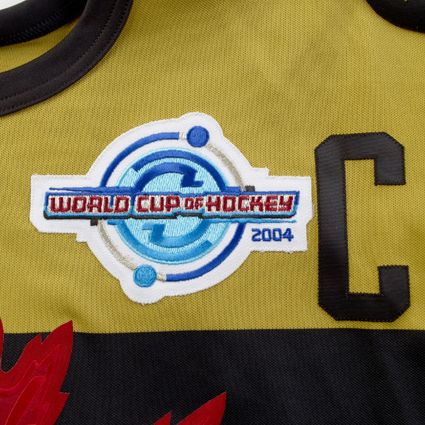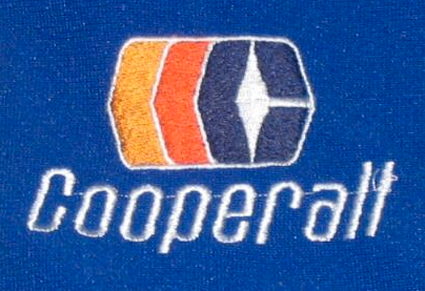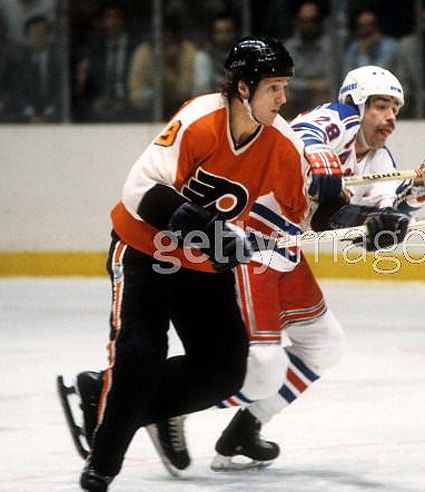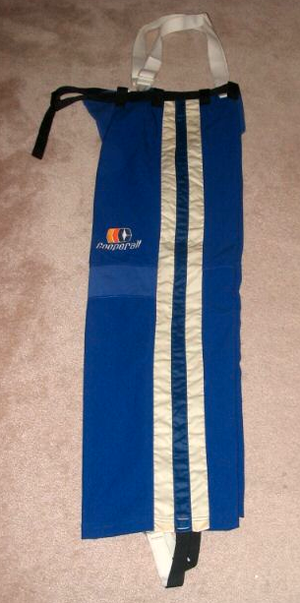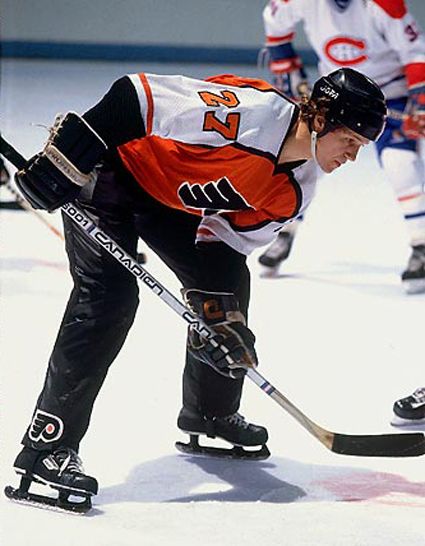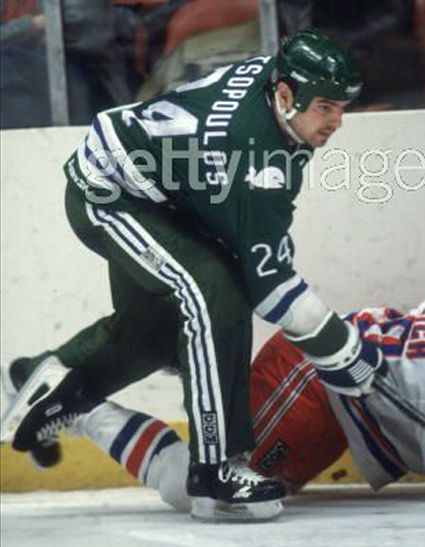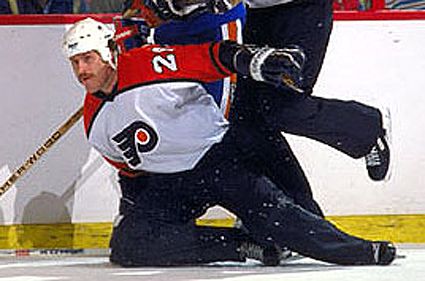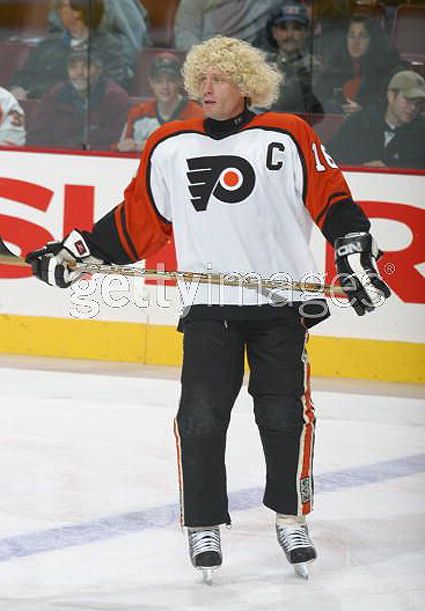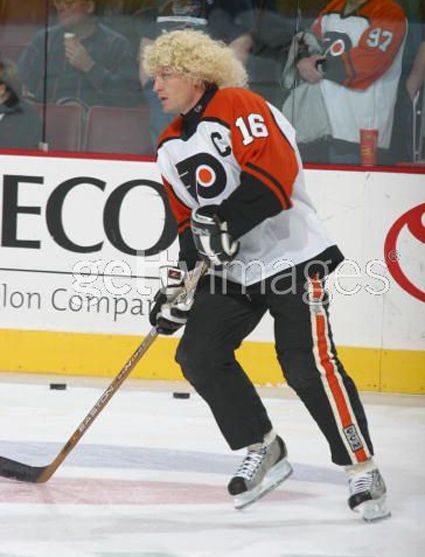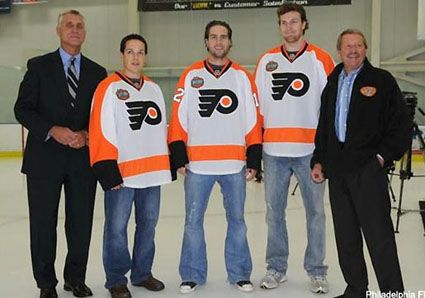Saturday, October 15, 2011
2011 Minnesota Hockey Collectors Expo Report
We recently attended the 2011 Minnesota Hockey Collectors Expo and saw some amazing jerseys and had some great conversations with fellow hockey jersey fans. Aside from the collector's who came to share their collections, former Minnesota North Star Brad Maxwell was in attendance this year, as was Minnesota Wild television broadcaster Mike Greenlay, as was one of his jerseys from his playing days, a common occurrence for any former players who attend the expo.
Speaking of former players, here is event organizer Dave Frechette with our host and former Minnesota North Star, Tom Reid.
In an effort to convey the spirit of the event, here are some photos from this year's gathering, which was the 10th annual one at Tom Reid's Hockey City Pub.
Above is Scott Janvrin's impressive Ben Clymer collection. Collecting one player, such as Clymer can be a challenge when they make multiple stops in the NHL and the AHL, but that challenge increases exponentially when a player extends his career by playing in Europe, so this collection was all the more impressive with the addition of game worn jerseys from the German DEL.
Kyle Oen brought his amazing game worn Minnesota high school jersey collection that rivals the one on display at the Xcel Energy Center. He also has other Minnesota based teams in his collection, such as the Minnesota Moose and Minnesota Gophers. Kyle's love of all things Minnesota hockey related is expressed in his website, VintageMinnesotaHockey.com.
Above is John Lindberg's take on a Minnesota theme. Where Kyle collects teams from Minnesota, John is more about former Gophers NHL jerseys as well as Minnesota Wild prospects jerseys before they reach the NHL.
Can't make it to the Hockey Hall of Fame in Toronto? Then having the opportunity to see Jon Bakke's collection of vintage jerseys can save you the trip. This year Jon went with a theme, bringing all his old Quebec Nordiques jerseys, the centerpiece of which are his Stastny brothers!
Jon can be easily spotted at Minnesota Wild games wearing his rotating collection of gamers, as he doesn't just hang them in a closet, he wears his regularly to Wild games.
Here is Jon sharing his collection with former North Star Maxwell, who probably had a few intense battles with the Nordiques before becoming one himself at one point in his career.
Speaking of Hall of Fame worthy collections, Dan Erspamer's Minnesota North Stars collection is highlighted with not only a first year North Stars jersey, but one belonging to the tragic Bill Masterton - a true gem of the expo. If you'd like to talk jerseys with Dan, he's an expert and can be found working at The Hockey Lodge store at Minnesota Wild home games, which take place just up the road from Reid's at the Xcel Energy Center.
Chris Groth (right) has his own hall of fame collection underway and goes for whatever catches his eye. He brought some real gems, including game worn jerseys from Luc Robitaille, Joe Sakic and Theo Fleury, but his Alexander Ovechkin game worn jersey was certainly an Expo highlight.
Eric Bodamer, who designed all the jerseys Nike supplied for the 1998 Olympic hockey tournament in Nagano, Japan, brought with his collection of game worn jerseys from his hometown Buffalo Sabres.
This collection with a Minnesota and Minnesota Wild theme was really impressive, particularly the Mikael Granlund jersey from HIFK Helsinki. Just how do people track these things down?! You have to appreciate dealing with the differences in time zone, language and currency when it comes to obtaining European jerseys!
Yes, you are seeing that right, it's a Milwaukee Admirals "Bob Uecker Night" jersey modeled after Uecker's infamous plaid sport coats! That jersey, and the rest of the collection on the table belong to Chris Jerina. The Uecker jersey, along with the Masterton jersey, was easily our favorite of the event.
Here was our contribution to the proceedings, our history of patches worn by the Minnesota Wild in their 10 years of play. We also brought our collection of game worn German National Team jerseys, which date from 1989 to 2009.
Another great person to meet was certainly Dan Schafer, who was the former equipment manager for the Minnesota Moose of the IHL. His Nordiques jersey from the late Stephane Morin was one of our personal highlights.
The walls of Tom Reid's are just dripping with hockey memorabilia and create the perfect environment to hold such an event.
Who says the event is just for guys?
Finally, the collection of event organizer Frechette, without whom the Expo would not exist. Dave's collection focuses primarily on Minnesota Wild players jerseys, only before they joined the Wild. Examples in his collection are Wild prospects jerseys from their college and junior team as well as European born players jerseys from their European club teams. He is shown with his new pride and joy, Dany Heatley's Ak Bars Kazan game worn jersey from Heatley's time in Russia during the lost NHL season of 2004-05.
How he is consistently able to track down jerseys from such a wide variety of sources is one of the more impressive things to take in at the Expo and his appreciation of hockey history is evidenced by the rare and wonderful Minnesota Fighting Saints WHA jersey seen here as well as his North Stars game worn jersey on display behind him.
Look for an announcement on the gameworn.net forums or this blog or on facebook for details of the the 11th annual expo in early October of 2012. It's a can't miss event, and remember, Chicks Dig the Game Worn Jerseys!
Labels:
Minnesota Hockey Collectors Expo
Friday, October 14, 2011
1991-92 New York Rangers Mike Gartner Jersey
Mike Gartner started his pro career with the Cincinnati Stingers of the World Hockey Association, having just turned 19 years old, below the NHL minimum age of 20 at the time.
His 27 goals and 52 points that season for the Stingers got the attention of the general mangers in the NHL, and Gartner was drafted 4th overall by the Washington Captials in the summer of 1979 following the demise of the Stingers as well as the WHA.
As a rookie with the Capitals, Gartner scored 36 goals, beginning a streak of 30 goals or more seasons that would eventually reach into the mid 90's.
In ten seasons with the Capitals, Gartner would average 39.7 goals per season and never less than 35 until the 1988-89 season when he was traded to the Minnesota North Stars 56 games into the season while currently at 26 goals. He would, however, score an additional seven goals in Minnesota to keep his streak going at ten seasons.
After enjoying so much stability in Washington, Gartner's time in Minnesota would be brief, as he was dealt to the New York Rangers after 67 games in 1989-90, but not before scoring 34 goals with the North Stars. After joining the Rangers, he would add 11 more to his season total which allowed him to reach the 40 goal mark for the sixth time.
Three consecutive 40 goal seasons in Manhattan followed, which included scoring his 500th NHL goal on this date in 1991. He would later surpass the 600 goal barrier as well as 1,000 points, prior to Gartner once more being on the move, this time to his hometown Toronto Maple Leafs. His 28 goals in 71 games in New York and the six he scored in 10 games with the Maple Leafs pushed his 30 goal streak to an NHL record 15 consecutive seasons.
The strike shortened season of 1994-95 only allowed Gartner to play in 38 games, limiting him to just 12 goals and unfairly ending his streak of 30 goal seasons at 15.
Back to a full season schedule in 1995-96, Gartner would run his 30 goal season total up to 16 with 35 goals. The Maple Leafs would trade Gartner to the Phoenix Coyotes in time for their first season in the desert, having just relocated from Winnipeg. There, Gartner would achieve his 17th season of 30 goals or more in his career, also a league record, when he scored twice on this date in 1997 in a 5-0 win over the Tampa Bay Lightning. His second goal of the night was also the 1,300th point in his NHL career.
Gartner would play one final season in the NHL with Phoenix. He would play in 60 games and score 12 goals, which included his 700th career goal, on the fifth player to ever reach that mark.
His final career totals are 708 goals, good for sixth all time, and 627 assists for 1,335 points.
While Gartner set records for his consistent goal scoring, he was probably better known for his speed, winning the always popular and high profile "Fastest Skater Competition" at the NHL All-Star Game each of the three times he entered, including 1993 when he scored four goals and was named the MVP of the All-Star Game.
During his career he would play in seven NHL All-Star Games and following his career he was inducted into the Hockey Hall of Fame in 2001 and his #11 was retired by the Capitals in 2008.
Today's featured jersey is a 1991-92 New York Rangers Mike Gartner jersey which features NHL 75th Anniversary patch on the upper left chest, while every other club, save the Philadelphia Flyers, wore the patch on their upper right chest. Having a unique patch placement when compared to other clubs is a common occurrence for the Rangers, due to the "R" of the diagonal Rangers cresting on their jerseys occupying the traditional location for patches. In general, the Rangers place additional patches on their right shoulder, but have used the left shoulder on occasion as well, as was the case with the 9/11 memorial ribbon patch.
Patches worn on the right shoulder include the Stanley Cup 100th Anniversary, the 1994 NHL All-Star Game, 1994 Stanley Cup Finals, the Rangers 75th and 85th Anniversary patches.
The only time the Rangers were able to join the flock was in 1999-00 when the NHL 2000 patch was a horizontal design, short enough to fit above the "R" in the space remaining.
Here is a great career retrospective of Mike Gartner's career on the occasion of his induction into the Hockey Hall of Fame, followed by his speech. The audio is a tad bit distorted, but still listenable.
Labels:
Gartner Mike,
New York Rangers
Thursday, October 13, 2011
2011-12 Ottawa Senators Daniel Alfredsson Jersey
The most exciting new jersey in the NHL this season, and quite possibly the last 15 years, makes it's debut tonight when the Ottawa Senators new third jersey takes to the ice this evening against the Colorado Avalanche.
The jersey originated as a concept by a fan, Jacob Barrette, who possessed a combination of graphic design skills and an appreciation for hockey history. Inspired by the Senators new secondary shoulder logos, which were introduced in 2007-08, the new third jersey pays tribute to the sweaters worn by the original Ottawa Silver Seven/Ottawa Senators franchise which played from 1883 to 1933 while wearing their gorgeous red, black and white striped "barberpole" jerseys as they were awarded, won or defended the Stanley Cup 21 times.
A 1927-28 Ottawa Senators barberpole style jersey
The new alternate jersey is black with red and antique white striping, a lace-up collar and will feature with the 2012 NHL All-Star Game patch. The new jersey is also adorned with shoulder patches inspired by the shield shaped chest patch shown on the above 1927-28 Senators jersey, which was worn to commemorate the Senators 1927 Stanley Cup championship. The patch on the right shoulder of the new jersey is in English, naturally reading "Ottawa Senators", while the one on the left side is in French, a unique twist for the NHL, and reads "Senateurs d'Ottawa".
In keeping with modern aesthetics, it's not a true barberpole with horizontal stripes covering the full length of the body and sleeves, but a black jersey with a pair of equal width red and antique white stripes across the chest and arms as well as the waist.
The names are one color antique white, as are the numbers, which are also trimmed in black and outlined in red, which creates a color-on-color effect when the top half of the numbers overlaps the red striping similar to the Detroit Red Wings 1991-92 Turn Back the Clock jerseys.
The only feature from the original Senators jerseys not carried over to the new third jerseys are the white squares on the back which contained the numbers, but with modern numbers being quite a lot larger than their distant cousins, the attractive way the numbers intersect the stripes on the back, we have no complaints about the omission in this case.
The Senators unveil the jersey to their fans
Today's video section consists of the Senators official videos released in conjunction with the official release of the jersey.
The first video is a photo shoot in advance of the unveiling, including a comments from Senators team captain Daniel Alfredsson and fan/designer Barrette.
The second video shows the club getting dressed in their new jerseys for the first time, amid the sounds of as much velcro ripping as you've ever heard in your entire life.
The third video is a must see, as it shows photos of the original Senators and how their sweaters are the basis for the new heritage uniform. It then goes on to detail Barette's involvement with the project, something quite unusual, if not completely unheard of, for an NHL team to acknowledge and include a fan in the design process. Those involved even travel to the Hockey Hall of Fame to view several original jerseys housed in the hall's collection.
The Senators will wear their new heritage jerseys 12 times this season, including once on the road in Montreal. The dates are as follows;
Thursday, Oct. 13, vs. Colorado
Sunday, Oct. 30, vs. Toronto
Friday, Nov. 4, vs. Montreal
Wednesday, Dec. 14, vs. Boston
Friday, Dec. 16, vs. Pittsburgh
Tuesday, Dec. 27, vs. Montreal
Tuesday, Feb. 7, vs. St. Louis
Saturday, Feb. 11, vs. Edmonton
Friday, March 2, vs. Chicago
Wednesday, March 14, at Montreal
Friday, March 16, vs. Montreal
Saturday, March 17, vs. Toronto
Dasherboard: Also of note in jersey news today, in an effort to raise funds for the families of the players killed in the September 7th plane crash that wiped out the entire roster of the Russian club Lokomotive Yaroslavl, both the Washington Capitals and Pittsburgh Penguins will be wearing jerseys with a commemorative Lokomotive Yaroslavl logo patch.
Following the game all the game worn and team issued jerseys will be autographed by the players and then auctioned through October 27th at nhl.com with all the proceeds to benefit the players' children and families.
Russians Alexander Ovechkin and Evgeni Malkin will take part in a ceremonial opening faceoff.
Labels:
Ottawa Senators
Wednesday, October 12, 2011
1992-93 Montreal Canadiens J. J. Daigneault Jersey
Born on this date in 1965, defenseman Jean-Jacques "J. J." Daigneault began his road to the NHL with the Laval Voisins of the QMJHL in the 1981-82 season. He spent 1982-83 with the Longueuil Chevaliers where he scored the most points of his career with 84 points in 70 games.
The Canadian National Team was his main focus for 1983-84, which included not only participating in the World Junior championship, but a trip to the Olympics as well. With is international commitments over, he returned to play an additional 10 games with Longueuil prior to being drafted by the Vancouver Canucks 10th overall in the 1984 NHL Entry Draft.
He graduated straight to the NHL in 1984-85, playing 67 games with the Canucks. After a second season in Vancouver, Daigneault began is trek through the NHL when he was traded to the Philadelphia Flyers for the 1986-87 season. Despite only scoring 6 goals in the regular season, he scored the winning goal in Game 6 of the Stanley Cup finals and to that point he had no points in 8 playoff games.
He divided his time in 1987-88 between the Flyers (28 games) and the Hershey Bears (10 games) of the AHL before starting the 1988-89 season with Hershey prior to a trade which sent him to the Montreal Canadiens organization and the Sherbrooke Canadians of the AHL where he played 63 games and had his only season with double digit goals as a professional with 10.
He was back in the NHL with the Montreal Canadians for 36 games in 1989-90 and also spent 28 with Sherbrooke. He became a regular with Montreal in 1990-91 where he spent the next five seasons, which included winning a Stanley Cup in 1993.
A trade early in the 1995-96 season sent him to the St. Louis Blues, who then sent him to Worcester of the AHL for a brief period before a late season trade who dealt him to the Pittsburgh Penguins, where he would get a chance to play with his childhood friend Mario Lemieux. Pittsburgh was his fourth different team of the season, which would set the tone for the remainder of his career.
Daigneault would not play an entire season with one team over the course of the next three seasons, starting 1996-97 with Pittsburgh, who dealt him to the Mighty Ducks of Anaheim after 53 games.
He began the 1997-98 season with the Mighty Ducks, who sent him packing to the New York Islanders for the final 18 games of the season.
He was next claimed by the Nashville Predators in the Expansion Draft for the 1998-99 campaign, only to have the Predators deal him to the Phoenix Coyotes halfway through the year.
The 1999-00 season saw him play 53 games with Phoenix, but following the year he packed his gear once again when he signed as a free agent with the Minnesota Wild, who assigned him to their top minor league affiliate, the Cleveland Lumberjacks, where he played in 44 games along with a single appearance for the Wild, which brought his total to record 10 different teams, becoming only the second player to do so after Michel Petit. That mark would later be surpassed by Mike Sillinger's 12 teams.
Daigneault would play 6 games with EHC Biel-Bienne in the Swiss second division in 2001-02 to close out his career. His final NHL totals were 899 games played, with 53 goals and 197 assists for 250 points.
Had Daigneault kept just one of each of the 27 different style jerseys he wore, 11 home, 10 road, 2 throwbacks and 4 alternates, here is a look at what his closet would contain.
aaaaaaaaaaaaaaaaaaaaaaaaaaaaaaaaaaaaaaIllustrations from NHLUniforms.com
Today's featured jersey is a 1992-93 Montreal Canadiens J. J. Daigneault jersey as worn during the pinnacle of Daigneault's career when he won the only Stanley Cup of his long career with his hometown Montreal Canadiens where he grew up five minutes from The Forum.
The Canadiens wore the Stanley Cup Finals patch on the upper right chest of their jerseys, as did their opponents the Los Angeles Kings, only the Canadiens version of the patch was in French, the only such time there were two variations of the finals patch in the same year.
1992-93 was a very busy year for the seamstresses in Montreal, as the Canadiens would start the season wearing the 1993 NHL All-Star Game patch for the first half of the season. After the All-Star Game, which they hosted, they would join the rest of the league in wearing the Stanley Cup 100th Anniversary patch, also in an unusual French variation shared only with the Nordiques, and then don the French version of the Stanley Cup finals patch for their third different patch of the season, a feat we're certain no other team has ever duplicated. Yes, several teams have worn three patches at the same time, but we're not aware of any team wearing three unique patches in the same season.
Today's video section begins with Daigneault's goal against Grant Fuhr in Game 6 of the 1987 playoffs. It was his first point of that season's postseason.
Next is Daigneault laying a check on none other than Wayne Gretzky.
Labels:
Daigneault,
Montreal Canadiens
Tuesday, October 11, 2011
1967-68 St. Louis Blues Gary Sabourin Jersey
Since the demise of the Brooklyn Americans in 1942, the NHL consisted of just six member teams, commonly referred to as "The Original Six". Finally, following the success of the Los Angeles Dodgers and San Francisco Giants of Major League Baseball on the west coast, the idea of expanding the NHL was first brought up in 1963, partly due to concerns that the Western Hockey League was intending to operate as a major league in the near future and also in hopes of making the league more attractive to American television networks with coast-to-coast appeal.
The original discussions promoted San Francisco and Vancouver as acceptable locations with Los Angeles and St. Louis also as potential candidates in March of 1965.
In February of 1966, applications were received from groups from Los Angeles, Pittsburgh, Minnesota, Philadelphia, San Francisco, Baltimore, Buffalo and Vancouver. But not St. Louis.
In the end, franchises were awarded to Oakland (across the bay from San Francisco), Los Angeles, Minnesota, Philadelphia, Pittsburgh and...
St. Louis!
The decision to exclude Vancouver caught many by surprise, especially those involved in the construction of the brand new Pacific Coliseum in Vancouver, and angered not only the locals, but all of Canada, since the six chosen cities were all in the United States. Various reasons emerged to explain the surprise inclusion of St. Louis, despite the fact there was no formal proposal from a group representing St. Louis.
Reportedly, the Toronto Maple Leafs and Montreal Canadiens did not want to share Canadian TV revenues with a third club and support for any expansion from the Chicago Black Hawks was contingent on the creation of a team in St. Louis, which would result in a near by rival as well as the sale of the run-down St. Louis Arena, which just conveniently happened to be owned by the Chicago Black Hawks ownership group at the time...
The St. Louis Arena
With the franchise now granted, the club's original owners spent several million dollars to massively renovate the arena, which included expanding it's capacity from 12,000 to 15,000 seats.
While Lynn Patrick was the original St. Louis Blues head coach, the legendary Scotty Bowman took over after a mere 16 games a roster which included veteran players Dickie Moore, leading scorer Red Berenson (51 points in 55 games after arriving in a trade) and goaltender Glenn Hall. While many of the players on the roster were NHL rookies or players with very limited NHL experience, they were not fresh-faced kids just out of juniors, but grizzled veterans with many seasons of minor league experience who were unable to crack the rosters of the Original 6 era, but who were more than capable of competing in the now 12 team NHL, some of whom would remain with the Blues for many seasons to come. Players such as Frank St. Marseille, Gary Sabourin, Barclay Plager, Noel Picard and Bob Plager.
The 1967-68 St. Louis Blues
That club would play the first game in franchise history on this date in 1967, when the Blues hosted their fellow expansion brothers the Minnesota North Stars at the arena in a game which ended in a 2-2 tie.
While the Blues had a rough early going, sinking to a 5-16-2 record, which included a 2-11 stretch in November and early December, the team came together following the coaching change to Bowman on November 20th. From December 9th to the end of January, the Blues reeled off a 13-5-6 run to climb to within 3 games of .500. Over the final two months of the campaign, the Blues won 9, lost 10 and tied 8 to finish the regular season with a 27-31-16 record for 70 points, just three back of the Philadelphia Flyers, and a spot in the playoffs.
As a way to allow the six new teams a chance to be competitive, or at least maintain the illusion of competitiveness for their fans, the six new clubs were placed together in the West Division, while the Original 6 teams comprised the East Division with the first two rounds of the playoffs conducted within one division, ensuring one of the new expansion teams a berth in the Stanley Cup finals.
The imbalance in the established clubs strength versus the six new teams was evident heading into the playoffs, as the fifth team in the East and first non-qualifyer for the playoffs, the Maple Leafs, had more points in the standings (76) than the all the teams in the West, led by Philadelphia's 73!
For whatever reason, the logic of the day dictated that the third place Blues drew the first place Flyers in the opening round, rather than the Flyers taking on the fourth place North Stars, as would be the case today. Regardless, the Blues, led by Hall's superb goaltending, shut out the Flyers at home in Game 1 by a score of 1-0. Philadelphia rebounded in Game 2 with a 4-3 win but St. Louis put the Flyers on the brink of elimination with 3-2 in overtime and 5-2 wins back at home.
The Flyers stayed alive with a dominant 6-1 back in Philadelphia and then forced a Game 7 when they defeated the Blues 2-1 in overtime in St. Louis. The Blues then eliminated the Flyers on the road 2-1 to advance to the semifinals where they would meet Minnesota.
That series would prove to be a knock-down, drag-out affair. The teams split the first two games in St. Louis, with the second one going to Minnesota in overtime. The North Stars took a 2-1 series lead before the Blues won the fourth game 4-3 in overtime to even the series at 2-2. St. Louis won 3-2 back at home in overtime followed by the North Stars holding serve at home in Game 6 by a score of 5-1. The deciding Game 7 was tied at 1-1 at the end of regulation before the Blues advanced to the Stanley Cup finals with the deciding goal at 22:50 of overtime, the fourth extra period of the seven game series.
Now forced to face the powerful Canadiens of the Original 6, the survivor of the East Division, the Blues acquitted themselves well, but fell in Game 1 3-2 in overtime and 1-0 at home before dropping Game 3 in overtime 4-3. Montreal then completed the sweep at home with a 3-2 win, bringing to an end the Blues exciting first season in the NHL. It would be the fourth game decided by a single goal thanks to the inspired play of Hall, who was praised by writer Red Burnett "A number of Hall's saves were seemingly impossible. Experts walked out of the Forum convinced no other goaltender had performed so brilliantly in a losing cause."
Today's featured jersey is a 1967-68 St. Louis Blues Gary Sabourin jersey from the Blues first season of play in the NHL. This first year Blues jersey is distinguished by the yellow waist and sleeve stripes, which would reverse colors for the playoffs and beyond.
Names were not worn on the backs of the white Blues jerseys until 1974-75. This original Blues style, albeit with the change in waist and sleeve stripes, would remain in use all the way through the 1983-84 season although the logo has stood the test of time and remains in use through today.
Today's video section begins with highlights of the 1968 Stanley Cup finals, set to some hip tunes probably better suited to surfing highlights.
Next is a better song, the one which inspired the club's name, the St Louis Blues sung by Bessie Smith.
Labels:
Hall Glenn,
St. Louis Blues
Monday, October 10, 2011
2004 Team Canada Mario Lemieux "Winnipeg Falcons" Jersey
Although it has been an annual celebration since 1879, following a parliamentary declaration in 1957, the second Monday in October has been celebrated as Thanksgiving Day in Canada. In honor of this long standing Canadian tradition, we present the oldest Canadian National Team sweater we could find, which also happens to belong to the world's first Olympic hockey champions, dating back to 1920.
The Winnipeg Falcons were founded in 1911 with a roster of players of Icelandic decent because they were not welcomed on other teams due to racial prejudice. The Falcons orginally played until 1917 and the team was then reorganized in 1919 after a number of their players returned from service in World War I.
The Falcons were chosen to represent all of Canada at the Olympic Games by virtue of having won the Allan Cup as the 1920 Canadian National Senior Amateur Champions.
During the 1920 Olympics the Falcons defeated Czechoslovakia 15-0, the United States 2-0 and Sweden 12-1 to capture the gold medal.
On their return to Canada, they were honored with a parade, given gold pocket watches and honored with several banquets.
On April 29th, 2006 the Winnipeg Falcons were inducted into Canada's Olympic Hall of Fame and there is now an exhibit in honor of the Falcons at the MTS Center in Winnipeg.
For further reading, there are now several books available about the Falcons, When Falcons Fly, Long Shot and Falcons Gold. We also recommend WinnipegFalcons.com, which proved invaluable in researching this entry.
When the North American pool of the World Cup of Hockey began in 2004, the United States travelled to Montreal to take on Team Canada, who wore 1920 Winnipeg Falcons throwback jerseys. Team Canada won the contest by a 2-1 score on goals by Martin St. Louis and Joe Sakic. It would be the only time Team Canada's senior team would wear the Falcons jerseys.
The jerseys were worn one once more, in an exhibition game between Canada's World Junior Team and Team Finland on December 20th, 2004 at the MTS Center in Winnipeg, which ended in a 6-0 win for Canada before they would go on to dominate the 2005 World Junior Tournament in Grand Forks, North Dakota with a team that included Sidney Crosby. The full roster of players from the exhibition game can be found here.
Crosby the only time he ever wore the Winnipeg Falcons jersey
Today's featured jersey is a 2004 Team Canada Mario Lemieux "Winnipeg Falcons jersey as worn on August 31st, 2004. One unique aspect of the Falcons throwbacks is that all the jerseys had "CANADA" on the back instead of each individual player's name, similar to the 1972 Canada Cup jerseys.
The jersey also features the 2004 World Cup of Hockey logo patch on the upper left chest, along with Mario Lemieux's captain's "C".
While the Falcons normally wore blue and green "barberpole" striped jerseys, it's uncertain why the Falcons' Olympic jerseys were old gold and black, a choice of colors that proved unpopular with fans in 2004 and earned them a spot in Third String Goalie's "Curious, Weird and Ugly" Collection.
Labels:
Canada,
Winnipeg Falcons
Sunday, October 9, 2011
A Brief History of Cooperalls - From the Broad Street Bullies to Brass Bonanza
Today marks the 30th anniversary of the sartorial splendor widely known as Cooperalls, for on this date in 1981, they made their NHL debut when the Philadelphia Flyers took to the ice in their full-length pants versus the Detroit Red Wings.
While many scoff at and scorn the Cooperalls, ranking them with other such sports uniform misfits as the 1976 Chicago White Sox shorts, we here at Third String Goalie embrace not only the concept of the Cooperalls, but their look as well. In our opinion, they made the players look taller and sleeker. If football and baseball players can look good in long pants, why not hockey players?
Even the basic idea of long pants for hockey players just makes so much sense to us. Why players would ever wear short pants for a winter sport played on ice, we will never quite understand...
The Cooperalls were first developed in order to increase player safety and protection, as the pads under the Cooperalls were held tightly to the body, unable to shift out of place like the current pads of the day, which would leave the player exposed to injuries, their tailbone in particular.
The original "Cooperalls" worn by the Flyers in 1981-82 were black with an orange stripe trimmed in white which ran down the length of the leg and were actually not Cooperalls, but a CCM version of the Cooperalls called CCM Pro Guard. Philadelphia completed their first season in the long pants with a 38-31-11 record, which was good for 87 points, placing them sixth in the Wales Conference.
Cooperalls were also reportedly worn by the Toronto Maple Leafs during the 1981-82 pre-season, but despite a reported game worn pair for sale on ebay, no photographic or video evidence of game action to support this claim is readily available.
For the 1982-83 season, the Flyers long pants returned, only this time in solid black, adorned only with a large Flyers logo at the ankle of each leg. Philadelphia rose to a 49-23-8 record, good for a Patrick Division title and second overall in the Wales Conference. Unfortunately for the Flyers faithful, they would be eliminated in the first round of the playoffs both seasons at the hands of the New York Rangers.
The Flyers were joined by the Hartford Whalers in wearing "Cooperalls" for the 1982-83 season, with the Whalers version featuring a full-length pair of blue stripes surrounded by three white stripes, which again were actually the CCM version.
The Whalers did the full length pants look no favors with their on-ice performance, as they tied for last in the league with 45 points following a 19-54-7 record.
Following the 1982-83 season the NHL outlawed the long pants on the grounds of player safety, as the outer fabric of the pants was made out of what was comparable to a nylon windbreaker which was more slippery than the traditional hockey pants/knit socks combination, and any player who fell while wearing them would skid relatively unabated into the boards at a much faster speed than previously.
Still, it wasn't just the Flyers and Whalers who wore the "Cooperalls", as Canada's junior leagues and high schools in Minnesota also wore them for a period of time.
Brendan Shanahan of the London Knights in his Cooperalls
Brett Hull of the Penticton Vees sporting his Cooperalls
For those of you who think that 1983 was the last of the "Cooperalls" on NHL ice, think again, for it was on Halloween night in 2002 that Jeremy Roenick took to the ice during warmups for the Flyers upcoming game against the Phoenix Coyotes wearing a blond wig, blacked-out front teeth, striped "Cooperalls" and a #16 Bobby Clarke sweater!
Perhaps it's now time to revisit the idea of the long pants. We're actually surprised that Reebok hasn't taken this one on yet. After all, they were bold enough to reinvent the hockey jersey, so why not change the pants while you are at it? Doing so certainly would have no doubt taken away some of the negative attention the the jerseys at the time.
Additionally, in the last 30 years there certainly have been many innovations and advances in fabric technology to the point that the basic excuse for banning Cooperalls in the first place, the slick fabric, could now easily be addressed by any number of equipment manufacturers.
After all, think of all the other men's sports at the Winter Olympics, alpine and cross-country skiing, bobsled and luge, curling, figure skating, speed skating, ski jumping and snowboarding, and just how many of those winter sports feature competitors wearing short pants? Right. Not one. Not even figure skating's Johnny Weir.
Even if the old guard would refuse to allow the return of the late, great Cooperalls full time, there is an opportunity staring us in the face that is just too good to pass up. The Flyers have been chosen to host the 2012 Winter Classic. In advance of that announcement some clever designer proposed a Flyers jersey based on the original Philadelphia franchise of the 1930's, the Quakers. While it is a darn fine concept, it was immediately put into production by the Chinese knockoff industry, ruining it's chances at life, as to now select that design would be to validate the bootleggers already extensive production run which has now flooded the market.
With that design now seemingly out, and the Flyers having had so few changes in style of their sweaters over the last 40 plus years, the one thing that has changed has been their pants, and the time is right for a return to the Cooperalls/CCM PRo Guard long pants of yore. It is, after all, an outdoor game, and wouldn't a nice warm pair of long pants (perhaps lined with some modern high tech Therma Base/Polartec/Thermal Dri-FIT/Play Warm fabric) be just the thing to keep you warm against winter's chill rather than shorts and socks? Jeremy Roenick thinks so...
Perhaps we could be so bold as to suggest denim Cooperalls for that "old time pond hockey look" for this year's Winter Classic? Now we're talking!
Daniel Briere, Simon Gagne and Braydon Coburn modeling the Flyers 2010 Winter Classic jerseys, complete with long pants,
an idea whose time has returned!
Today's featured pants are the 1981-82 Philadelphia Flyers "Cooperalls". Not actually Cooperalls, but CCM Pro Guard pants, they were worn for only a single season. These pants, with their elegant long stripe down the leg, which served to accentuate that the pants were indeed full length, were a shock to the established look when they first appeared.
The stripe on the Flyers pants disappeared for the second season, with just a Flyers logo waaaaay down by the ankle of the otherwise all-black pants. Meanwhile, four hours to the north, the Hartford Whalers also adopted the long pants for one season and went all out to call attention to the full length of their pants with no less than five alternating white and green stripes.
While Philadelphia and Hartford actually both wore the CCM Pro Guard pants, the name "Cooperalls" has become the popular nomenclature for the full length hockey pants in the same way that all brands of tissues are commonly referred to as "Kleenex" while copiers are often referred to as a "Xerox machine" regardless of brand.
Today's video segment begins with footage of the Flyers wearing their Cooperalls from the first season of use, noted by the orange stripe down the legs.
This next clip from the WHL features Cam Neely of the Portland Winterhawks going toe-to-toe with Shawn Green of the New Westminster Bruins while both were wearing Cooperalls in the 1983-84 season.
In this next clip from the 1984 Minnesota State High School Hockey Tournament, St. Paul Johnson takes on the Hill-Murray Pioneers during the Cooperall era. Note the clear boards of the old St. Paul Civic Center to complete the obscurity double!
Even French-Canadians and Soviets liked Cooperalls!
Labels:
Cooperalls,
Hartford Whalers,
Philadelphia Flyers
Subscribe to:
Comments (Atom)

